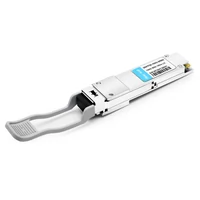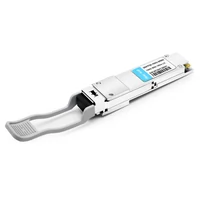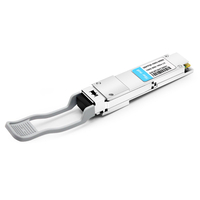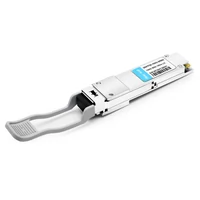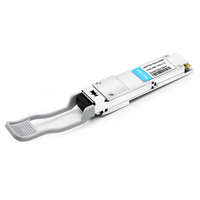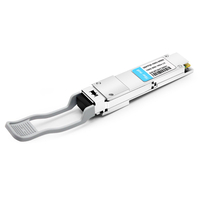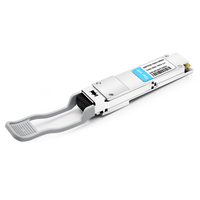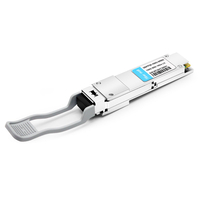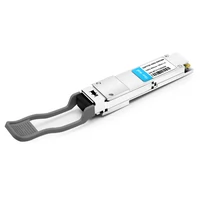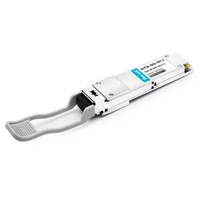With the rise of cloud computing and 5G networks, data centers tend to develop at higher rates, and the demand for 100G optical transceiver modules is increasing. Nowadays, 100G optical modules occupy a large proportion of the network construction cost. In the application environment within data centers, over 90% of fiber links in small and medium-sized data centers are less than 100 meters long. In large data centers, more than 70% of fiber links are less than 100 meters long, and more than 80% are less than 125 meters long. Multi-mode fiber can meet the needs of most of the links, so the 100G multi-mode module has the greatest demand. The QSFP28 100G multi-mode module has three mainstream solutions: 100GBASE-SR BD, 100GBASE-SR4, 100GBASE-SWDM4, and 100G QSFP28 BiDi SR1.2.
1. Product specifications
Among the three 100G multi-mode modules, 100GBASE-SR4 is the most widely used. The 100G QSFP28 SR4 is a hot-plugged full-duplex optical module with a center wavelength of 850nm and conforms to IEEE 802.3BA standards. It is specially used for short-distance transmission in 100G Ethernet. The 100G QSFP28 SR4 optical module can provide four independent send and receive channels, each of which can operate at a rate of 25Gbps. Using MPO or MTP interface (8-core), the transmission distance is 70m when it is used with OM3 multi-mode fiber, and 100m when it is used with OM4 multi-mode fiber. Its working principle is shown below:
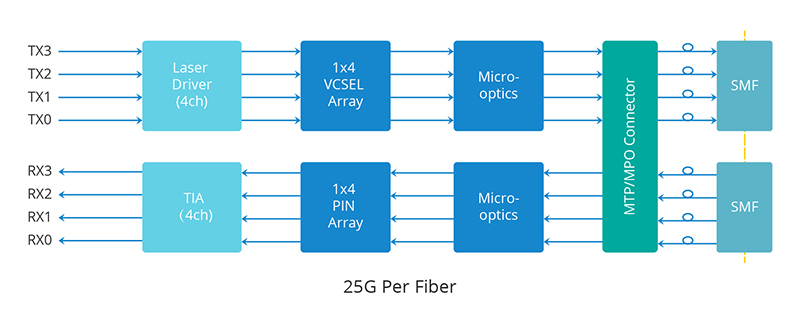
working principle of 100G QSFP28 SR4
Different from the 100G QSFP28 SR4, which requires eight optical fibers for transmission, the 100G QSFP28 SR BiDi (Bidirectional) module uses WDM technology to enable each LC port to simultaneously transmit and receive optical signals of different wavelengths from a multi-mode fiber. The two LC interfaces can transmit and receive 100G signals in total. Dual wavelength VCSEL bi-directional optical interface, PAM4 2 × 50-Gb/s 850nm/900 nm. These modules are designed to operate on multi-mode fiber systems using wavelengths of 850nm at one end and 900nm at the other. They can transmit up to 70 meters when used with OM3 fiber patch cable, up to 100 meters when used with OM4 fiber patch cable, and up to 150 meters when used with OM5 fiber patch cable. The working principle is as follows.
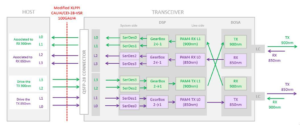
working principle of 100G QSFP28 SRBD
The 100GBASE-SWDM4 is similar to the 100G QSFP28 SR BiDi in that both have duplex LC interfaces. SWDM refers to the short-wave wavelength division multiplexing technology, similar to CWDM4 and LWDM4 single-mode schemes, through MUX/DMUX to realize the combined splitting of waves and transmit optical signals of four bands on a core multi-mode fiber. The windows of the four bands are 850nm, 880nm, 910nm, and 940nm; the maximum transmission distance is 70 meters when used with OM3 fiber patch cable, and up to 100 meters when used with OM4 fiber patch cable. The working principle is as follows.
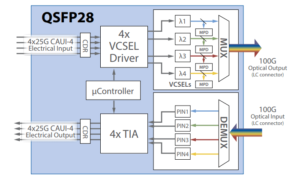
working principle of 100G QSFP28 SWDM4
Mission-critical workloads such as artificial intelligence (AI) and machine learning are increasing computing and traffic demands within structures, driving a shift to denser and faster connections within the ridges and backbones of data centers and between ridge/rack top switches and servers. When upgrading a traditional data center from 10G to 40G or 100G, the LC duplex cabling connecting to the SFP optical module must be converted to the MPO cabling connecting to the QSFP optical module, which increases operating costs. How can wiring be simplified and capital expenditure reduced? The optical module using BiDi solution can do this, 100G QSFP28 BiDi SR1.2 is such a product.

FiberMall 100G QSFP28 BiDi SR1.2
Very similar to the 40G QSFP+ SR BiDi optical module, the 100G QSFP28 BiDi SR1.2 allows data center operators to reuse their existing duplex LC jumper infrastructure when upgrading from 10G SR or 40Gb BiDi to 100G. By upgrading network devices of one terminal at a time, the carrier can flexibly upgrade the data center.
100G QSF28 SR1.2 is a Quad Small Form-factor Pluggable (QSFP28) BiDi optical module. It supports 100Gbps and conforms to IEEE802.3bm 100GBASE-SR4. The module adopts dual-core duplex LC multi-mode optical fiber. It adopts 4×25G NRZ modulation at the electrical end and converts to 2x50Gbps PAM4 modulation at the optical end. The total bandwidth is 100Gb. The PAM4 technology supports signal transmission at 50Gb data rates and 25Gbaud rates.

The 100G QSFP28 SR BiDi is used in pairs for 100G connectivity and can also be connected to the 400G QSFP+ SR BiDi in 4 x 100G branch mode.

It can be seen that although the four modules need to be used with multi-mode optical fibers, the technical principles of the modules are not the same. 100G QSFP28 SR4 adopts four-channel parallel transmission, so at least 8 optical fibers are needed to complete the transmission (four receiving and four transmitting). 100GBASE-SR BD uses a single optical fiber to transmit and receive 50G data, and the two interfaces jointly transmit 100G data. 100GBASE-SWDM4 uses wavelength-division multiplexing (WDM) technology to multiplex signals of four bands into one optical fiber for transmission. Two optical fibers are needed for receiving and transmitting.
| Product Specification | Module Cost | Cabling Cost | Product Ecology | Application Commonality | Application Differences |
|---|---|---|---|---|---|
| QSFP28 100G SR4 | low | high | excellent | All need to be used with multi-mode fiber | MPO Interface |
| QSFP28 100G SRBD | high | low | good | Duplex LC Interface | |
| QSFP28 100G BiDi SR1.2 | low | low | good | ||
| QSFP28 100G SWDM4 | average | low | poor |
2. Product Application Selection
All three modules are compatible with the mainstream 100G QSFP28 port, and although there is a big difference in technical specifications, there is little difference in application: 100GBASE-SR4 must be used with MPO 8/12 core multi-mode jumper, 100GBASE-SR BD and 100GBASE-SWDM4 must be used with duplex LC multi-mode fiber. From the perspective of fiber resources and cabling cost, the fiber resources of 100GBASE-SR BD and 100GBASE-SWDM4 cabling only require 1/4 of that of 100GBASE-SR4, which can significantly save the capital expenditure of fiber infrastructure. However, the cost of 100GBASE-SR BD and 100GBASE-SWDM4 modules is much higher than that of 100GBASE-SR4. Therefore, from the perspective of the overall cost of optical module + fiber, Using 100GBASE-SR BD or 100GBASE-SWDM4 is not necessarily lower than using 100GBASE-SR4.
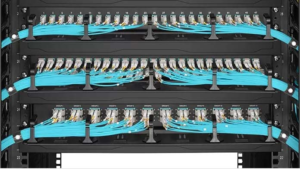
Duplex Multi-Mode Cabling in Data Centers
Why do some customers choose 100GBASE-SR BD and 100GBASE-SWDM4 when the overall application cost is higher than 100GBASE-SR4? After communicating with the customer, the technical personnel of FiberMall found that 100GBASE-SR BD or 100GBASE-SWDM4 was selected because the network demand was upgraded from the original 10G/25G to 100G, and the network wiring of 10G/25G was mainly LC duplex multi-mode Fiber. If the QSFP28 100G SR4 module is used, the original wiring needs to be greatly adjusted, and the cost would be extremely high. Therefore, 100GBASE-SR BD or 100GBASE-SWDM4 with LC interface will be chosen.
Although 100GBASE-SR BD and 100GBASE-SWDM4 are both duplex LC interfaces, there is a huge difference in technology. It is known that now few manufacturers in the world produce 100GBASE-SWDM4. FiberMall is one of the optical module manufacturers that can produce 100G QSFP28 SWMD4, which is used by fewer customers and has some instability in chip supply. 100GBASE-SR BD has a high technical threshold. FiberMall has started mass shipment from 2020, and the ecological development of products is good. FiberMall recommends 100G QSFP28 SR BD optical modules for 100G networks in data center duplex multimode cabling environments.
The advantages of 100G QSFP28 BiDi SR1.2
- Reduce capex by reusing duplex LC multi-mode fiber infrastructure
- Reduce operating expenses by seamlessly upgrading from 10Gbps SR or 40Gbps BiDi to 100Gbps rates
- Prepare for future network upgrades by providing 400 Gbps rate connections
- Use KP4 forward error correction (FEC) to reduce transmission errors at 100Gbps data rates
Data Center Cabling with 100G QSFP28 BiDi SR1.2
As shown below, the 400G QSFP-DD BiDi SR4.2 can be deployed in the spine layer, which acts as the backbone of the network, with branches connected to the leaf nodes. Deploy 100G QSFP28 BiDi SR1.2 in the backbone and leaf nodes and upgrade the backbone to 400G as bandwidth demands grow.
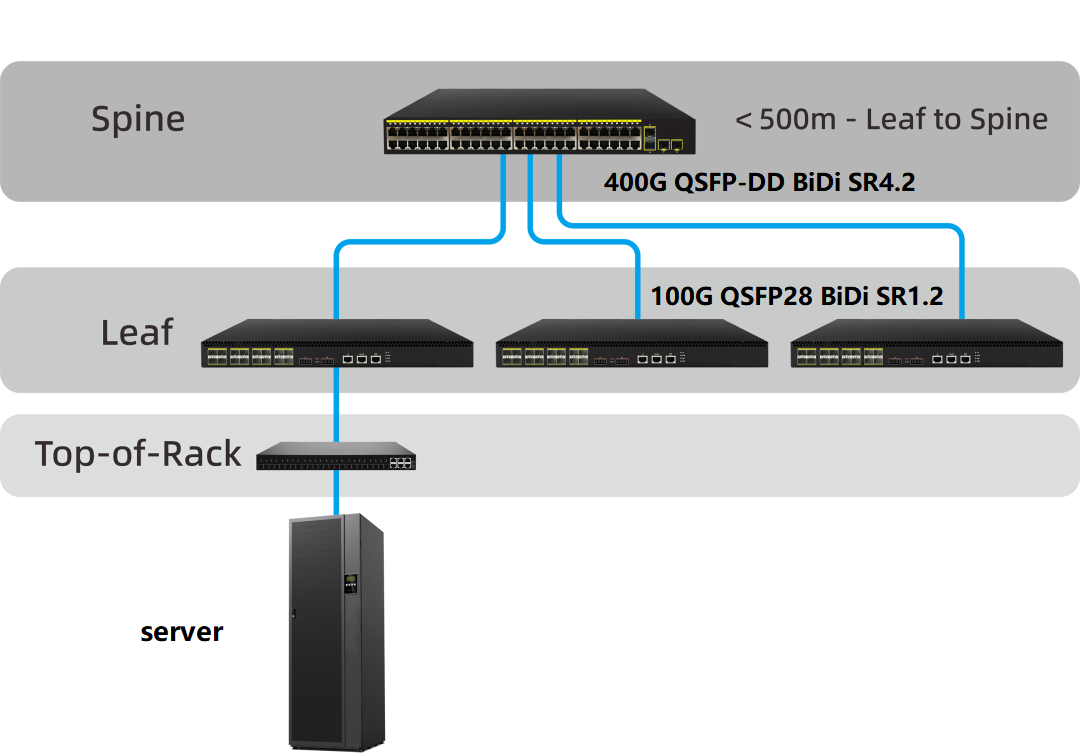
Data center topology of leaf ridge architecture
As shown below, pluggable optical modules offer greater reach and operational flexibility than pre-assembled cables (DAC/AOC). Operators can use 100G QSFP28 BiDi SR1.2 for top-of-rack connectivity to servers or deploy 400G in TOR with branch connectivity downstream. Connect 1×400G QSFP-DD BiDi SR4.2 with 4×100G QSFP28 BiDi SR1.2 to the server.
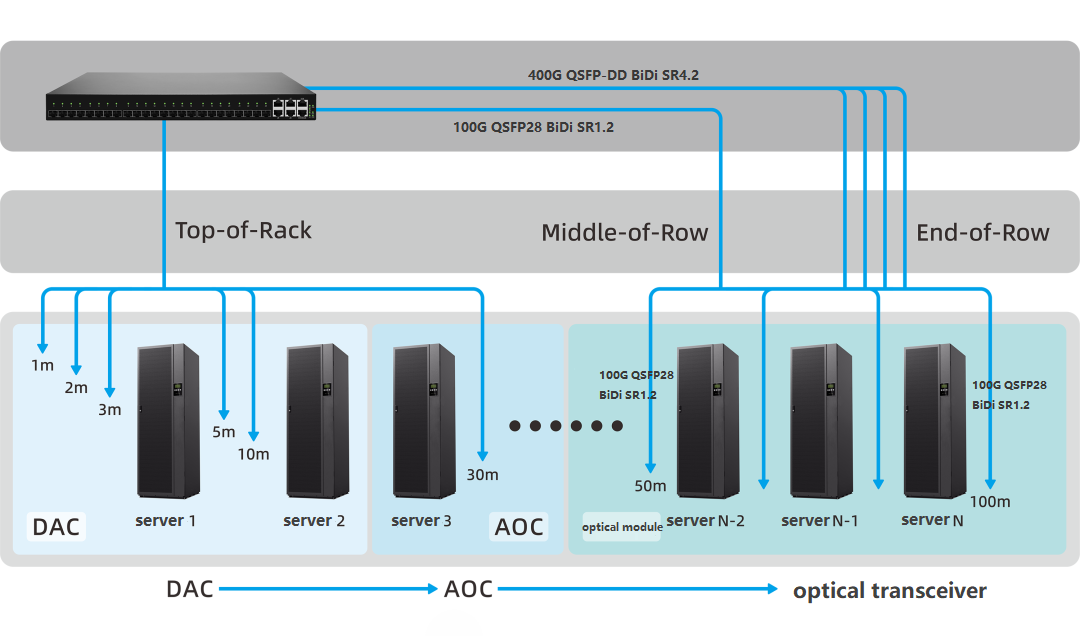
Data center topology for switch-to-server connectivity
In short distance connection of data center, FiberMall can not only provide 100G QSFP28 BiDi SR1.2 but also 40G QSFP+ SR BiDi and 100G QSFP28 SWDM4 can also continue to use duplex LC multimode jumper. It can replace the 40G QSFP+ SR4 and 100GE QSFP28 SR4 optical modules, greatly saving optical fiber resources and simplifying optical fiber management in the data center.
Table of Contents
ToggleRelated Products:
-
 Cisco QSFP-40/100-SRBD Compatible Dual Rate 40G/100G QSFP28 BIDI 850nm & 900nm 100m LC MMF DDM Optical Transceiver
$449.00
Cisco QSFP-40/100-SRBD Compatible Dual Rate 40G/100G QSFP28 BIDI 850nm & 900nm 100m LC MMF DDM Optical Transceiver
$449.00
-
 QSFP28-100G-SRBD Dual Rate 40G/100G QSFP28 BIDI 850nm & 900nm 100m LC MMF DDM Optical Transceiver
$449.00
QSFP28-100G-SRBD Dual Rate 40G/100G QSFP28 BIDI 850nm & 900nm 100m LC MMF DDM Optical Transceiver
$449.00
-
 AVAGO Broadcom AFBR-89BDDZ Compatible Dual Rate 40G/100G QSFP28 BIDI 850nm & 900nm 100m LC MMF DDM Optical Transceiver
$449.00
AVAGO Broadcom AFBR-89BDDZ Compatible Dual Rate 40G/100G QSFP28 BIDI 850nm & 900nm 100m LC MMF DDM Optical Transceiver
$449.00
-
 Arista Networks QSFP-100G-SRBD Compatible Dual Rate 40G/100G QSFP28 BIDI 850nm & 900nm 100m LC MMF DDM Optical Transceiver
$449.00
Arista Networks QSFP-100G-SRBD Compatible Dual Rate 40G/100G QSFP28 BIDI 850nm & 900nm 100m LC MMF DDM Optical Transceiver
$449.00
-
 Dell Q28-100G-BIDI Compatible Dual Rate 40G/100G QSFP28 BIDI 850nm & 900nm 100m LC MMF DDM Optical Transceiver
$449.00
Dell Q28-100G-BIDI Compatible Dual Rate 40G/100G QSFP28 BIDI 850nm & 900nm 100m LC MMF DDM Optical Transceiver
$449.00
-
 H3C QSFP-100G-BIDI-MM850 Compatible Dual Rate 40G/100G QSFP28 BIDI 850nm & 900nm 100m LC MMF DDM Optical Transceiver
$449.00
H3C QSFP-100G-BIDI-MM850 Compatible Dual Rate 40G/100G QSFP28 BIDI 850nm & 900nm 100m LC MMF DDM Optical Transceiver
$449.00
-
 HPE X150 JQ344A Compatible Dual Rate 40G/100G QSFP28 BIDI 850nm & 900nm 100m LC MMF DDM Optical Transceiver
$449.00
HPE X150 JQ344A Compatible Dual Rate 40G/100G QSFP28 BIDI 850nm & 900nm 100m LC MMF DDM Optical Transceiver
$449.00
-
 Juniper JNP-QSFP-100G-BXSR Compatible Dual Rate 40G/100G QSFP28 BIDI 850nm & 900nm 100m LC MMF DDM Optical Transceiver
$449.00
Juniper JNP-QSFP-100G-BXSR Compatible Dual Rate 40G/100G QSFP28 BIDI 850nm & 900nm 100m LC MMF DDM Optical Transceiver
$449.00
-
 QSFP28-100G-SWDM4 100G QSFP28 SWDM4 850nm-940nm 100m LC MMF DDM Optical Transceiver
$300.00
QSFP28-100G-SWDM4 100G QSFP28 SWDM4 850nm-940nm 100m LC MMF DDM Optical Transceiver
$300.00
-
 QSFP28-100G-SR1.2 Single Rate 100G QSFP28 BIDI 850nm & 900nm 100m LC MMF DDM Optical Transceiver
$280.00
QSFP28-100G-SR1.2 Single Rate 100G QSFP28 BIDI 850nm & 900nm 100m LC MMF DDM Optical Transceiver
$280.00

